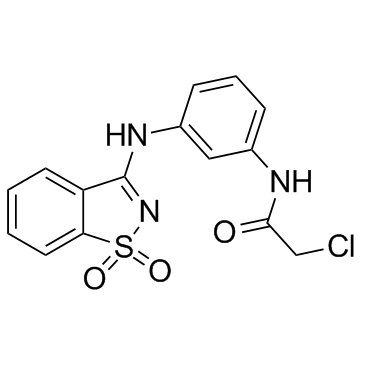1449236-96-7
| Name | NMS-859 |
|---|---|
| Synonyms |
3-[(1,1-Dioxido-1,2-benzothiazol-3-yl)amino]phenyl chloroacetate
MFCD05030984 Acetic acid, 2-chloro-, 3-[(1,1-dioxido-1,2-benzisothiazol-3-yl)amino]phenyl ester |
| Description | NMS-859 is a potent, covalent VCP (p97) inhibitor, with IC50s of 0.37 and 0.36 μM for wild-type VCP in the presence of 60 μM and 1 mM ATP in cells, respectively. |
|---|---|
| Related Catalog | |
| Target |
IC50: 360 nM (Cellular p97, 1 mM ATP), 370 nM (Cellular p97, 60 μM ATP)[1] |
| In Vitro | NMS-859 is a potent VCP inhibitor, with IC50s of 0.37 and 0.36 μM for wild-type VCP in the presence of 60 μM and 1 mM ATP in cells, respectively. NMS-859 shows very weak inhibitory activity against VCPC522T. NMS-859 also suppresses the proliferation of cells, with IC50s of 3.5 μM and 3.0 μM in HCT116 and HeLa cell lines, respectively[1]. |
| Cell Assay | Cells are seeded at 1,600 cells per well in 384-well white clear-bottom plates. Twenty-four hours after seeding, cells are treated with NMS-859 (eight dilution points, in duplicate) and incubated for an additional 72 h at 37°C under a 5% CO2 atmosphere. Cells are then lysed, and the ATP content in each well is determined using a thermostable firefly luciferase-based assay as a measure of cell viability. IC50 values are calculated using the percentage of growth of treated cells versus the untreated control[1]. |
| References |
| Density | 1.5±0.1 g/cm3 |
|---|---|
| Boiling Point | 540.7±56.0 °C at 760 mmHg |
| Molecular Formula | C15H12ClN3O3S |
| Molecular Weight | 349.789 |
| Flash Point | 280.8±31.8 °C |
| LogP | 2.08 |
| Vapour Pressure | 0.0±1.4 mmHg at 25°C |
| Index of Refraction | 1.673 |
| Storage condition | 2-8℃ |
